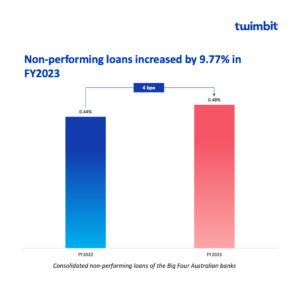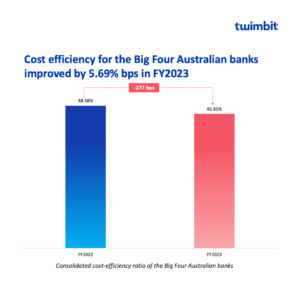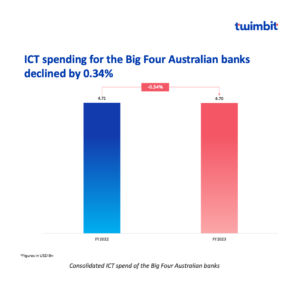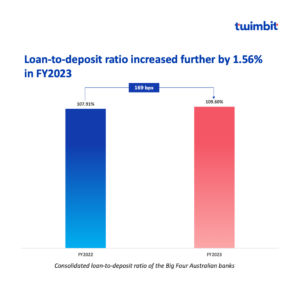Market highlights
The Big Four Australian banks have reported robust earnings in FY 2023. Despite intense pricing competition throughout the year, the impact of cash rate increases and the peak in the net interest margin (NIM) has resulted in increased revenues.
The country’s inflation appears to have peaked at 5.4%, indicating the impact of the Reserve Bank of Australia’s interest rate hikes of 425 basis points (bps). Despite this positive development, numerous households are grappling with persistent difficulties arising from inflation. This situation led to an increase in the value of mortgage payments for many homes, subsequently diminishing their disposable income.
Revenue
Operating income of Australian banks grew by 10.9% to USD 60.42 billion in FY 2023 from FY 2022
This growth was driven by a 13.76% growth in the net interest income from USD 44.02 billion to USD 50.08 billion.
NAB
- Highest revenue growth at 12.89%, from USD 12.24 billion in FY 2022 to USD 13.82 billion in FY 2023
- Highest growth in operating expenses at 9.05%, from USD 5.53 billion to USD 6.04 billion
Westpac
- Lowest growth in operating income at 8.22%, from USD 13.32 billion in FY 2022 to USD 14.41 billion in FY 2023
- 10.89% growth in net interest income was partially offset by a 5.18% decline in non-interest income from USD 2.21 billion to USD 2.09 billion
- Declining fee incomes specifically due to the sale-off of business, which generated USD 392 million in FY 2022 and only USD 140 million in FY 2023
The sale of the business was concluded in Q1 2023, and therefore, no revenue was generated in Q2 and Q3 2023.
Exhibit 1: Net revenues for the Big Four Australian banks
Profitability
Net profit grew by 12.2% YoY to USD 21.5 billion in FY 2023 from FY 2022
- Highest net profit growth at 26.36% from USD 3.81 billion in FY 2022 to USD 4.81 billion in FY 2023
- Driven by a 6% growth in average interest-earning assets due to loan growth and higher liquid assets
- Loan portfolio grew by 4.56% from USD 495 billion to USD 517 billion
Exhibit 2: Consolidated net profits of the Big Four Australian banks
Fee-based income
Fee income declined by 1.05% to USD 5.63 billion in FY 2023 from FY 2022
All banks reported declining fee incomes, except NAB, which reported a small growth in fee incomes at 3.02%. CBA reported a decline in its fee income at 2.88% due to:
- Lower CommSec equities income and lower institutional lending fees
ANZ reported a decline in its fee income at 2.36% due to:
- USD 54.85 million decrease in the Australian Commercial division driven by lower revenue post Worldline business divestment
- USD 20.07 million decrease in the New Zealand division driven by lower card revenue due to regulatory fee changes introduced in November 2022
Westpac reported a decline in its fee income at 1.61% due to:
- Lower income from product simplification and lower wealth management income post-divestment
The changes in the 3 banks mentioned above were marginal regarding dollar value.
Exhibit 3: Fee incomes of the Big Four Australian banks
The overall fee income growth has been stagnant for Australian banks. However, certain sectors have experienced an uptick in fee revenue. Notably, fees for medium and large businesses, comprising around 65% of the bank’s total fee income, have risen alongside transaction fees like ATM fees and overdraft charges.
Moreover, heightened demand for financial products and services, such as loans, credit cards, and investment management, has increased fee income. Fee income trends in Australian banks are diverse, encompassing growth and decline in various sectors.
Net interest margins (NIM)
NIM has gone up by 10 bps in FY 2023 from FY 2022
The average NIM for Australian banks stood at 1.84% in FY2023 (Exhibit 4), up from 1.74% in FY 2022. All the banks reported an increase in their NIMs. The RBA’s tightening of monetary policy was the key driver of NIMs, which increased by an average of 10 bps between FY 2022 and FY 2023.
Australian banks have some of the lowest NIMs among the APAC regions. This is due to lower home loan margins, continued pricing pressure on mortgages and changing customer preference from fixed-rate to floating-rate loans.
- Interest margins are under pressure due to intense pricing competition in the mortgage market and the rising cost of deposits and wholesale funding.
- Net interest income grew by 13.76% from USD 44.02 billion in FY 2022 to USD 50.08 billion in FY 2023.
- Interest income grew by 99.08%, from USD 62.57 billion to USD 124.56.
- Interest expense grew by 310% from USD 18.18 billion to USD 74.55 billion.
Exhibit 4: Consolidated net interest margins of the Big Four Australian banks
Non-performing loans (NPL)
NPL increased by 4 bps in FY 2023 from FY 2022
The average NPL of the Big Four witnessed a 4 bps increase (Exhibit 5), resulting in a current NPL of 0.48%. On average, the NPLs grew by 9.77% between FY 2022 and FY 2023. It should be noted that Australian banks are among the lowest NPLs in the APAC region.
Of the four banks, CBA reported a decline in its NPL from 0.36% in FY 2022 to 0.33% in FY 2023. All the other banks reported a decrease in their NPL between FY 2022 and FY 2023:
- ANZ increased by 4 bps from 0.36% to 0.40%
- Westpac increased by 10 bps from 0.51% to 0.61%
- NAB increased by 6 bps from 0.51% to 0.57%
NPL in Australia has inherently low NPL because of:
- Sound lending policies – The Australian Prudential Regulation Authority (APRA) has strict capital requirements and lending standards that help to protect banks from risky lending practices
- Diversified loan portfolios – Australian banks have diversified loan portfolios, which has helped reduce their exposure to any sector of the economy
- Superior underwriting
- Stringent credit checks
Exhibit 5: Consolidated non-performing assets of the Big Four Australian banks
Cost
Cost efficiency (CE) for Australian banks improved by 5.69% between FY 2022 and FY 2023
Australian banks operate at an efficiency close to the threshold value of 50%. The average cost efficiency of Australian banks has improved from 48.58% in FY 2022 to 45.81% in FY 2023 (Exhibit 6).
In FY 2022, ANZ and Westpac had their cost efficiencies at 51.65% and 51.15%, respectively, above the threshold value of 50%. However, in FY 2023, all the banks had their cost efficiency below the threshold value; CBA led the pack with a cost efficiency of 43.54%, closely followed by NAB at 43.69%.
Exhibit 6: Consolidated cost-efficiency ratio of the Big Four Australian banks
ICT spending for Australian banks declined by 0.34% in FY 2023
The Big Four reported a decline in ICT spending from USD 4.71 billion in FY 2022 to USD 4.7 billion in FY 2023 (Exhibit 7). The average ICT spend to revenue stood at 7.77% in FY 2023, down from 8.65% in FY 2022.
- Average ICT spending has decreased to USD 1.17 billion.
- CBA reported a decline in ICT spending at 13.69%, from USD 1.58 billion in FY 2022 to USD 1.36 billion in FY 2023.
CBA
- IT expenses declined due to lower amortisation and write-offs of software assets, which were reduced by 48.09% from USD 509 million to USD 264 million.
- Partially offset by a 7.88% increase in the system development and support cost from USD 662 million to USD 714 million.
Westpac
- Inflation contributed to higher third-party vendor costs, increasing software maintenance and license costs.
- Experienced higher software amortisation related to growth, productivity and regulatory and risk investments.
ANZ
- Increased expenses were driven by incremental costs associated with strategic initiatives, higher software license costs, inflationary impacts on vendor costs, and costs previously attributed to discontinued operations.
Exhibit 7: Consolidated ICT spend of the Big Four Australian banks
Loan-to-deposit ratio (LDR)
LDR for Australian banks increased by 169 bps in FY 2023
The average LDR for Australian banks grew by 1.56% from 107.91% in FY 2022 to 109.6% in FY 2023 (Exhibit 8).
Australian banks have historically high LDR as loans comprise most of their business. In recent years, low-interest rates led to a borrowing surge in debt and low deposit rates, which reduced customers’ incentive to save and increased LDR.
High LDR for Australian banks puts them under pressure to maintain sufficient reserves that cover unexpected contingencies and cash runouts.
Exhibit 8: Consolidated loan-to-deposit ratio of the Big Four Australian banks
Top initiatives by Australian banks
CBA reimagines customer journeys via digital channels
Exhibit 9: Journey 1 – Home buying and ownership
Exhibit 10: Journey 2 – Payments
Exhibit 11: Journey 3 – Customer rewards
CommBank app 5.0
- Automatic login – Faster experience by securely logging in as soon as the ap opens
- Quick links – Personalised navigation titles based on customer’s in-app behaviour
- App library and enhanced search – Simplified catalogue of app features, products and services, as well as improved app-wide search functionality
- Business profile switching – Switch options allow business customers to toggle between business and personal accounts easily
- Investing functionality – Enables users to browse and invest in Australian shares and Exchange Traded Funds (ETFs)
NAB invests in enhancing its digital banking touchpoints for superior CX
In FY 2023, the bank delivered the following features to its digital channels to provide simpler, safer and more personalised customer experiences (CX).
NAB Mobile App
- Apply for new products directly via the app
- View and control bills and payments with PayTo
- Enhancements to in-app calling when updating SMS security
- Proactive scams and fraud alerts in key payment flows
NAB Internet Banking
- Real-time authenticated chat
- Customers can easily apply for business transaction accounts within internet banking
- Proactive scam and fraud alerts
- Proactive and targeted notifications
NAB Connect
- Faster payments via the all-new Domestic OPayments experience
- Increase self-service support and help capabilities
- Enhanced security and fraud warnings for security tokens
- Equipment finance capability
- Introduced a new digital user amendment process
Innovating with NAB Ventures – Works alongside other parts of the bank that incubate and test innovative new customer propositions and leverage new technological developments.
Exhibit 12: NAB Venture’s new and follow-up investments in FY 2023
ANZ unlocks value for customers with customer journey management and strategic partnerships
ANZ Plus allows customers to automate their home loan journey without human intervention.
Exhibit 13: ANZ Plus’ automated home loan journeys
Partnership with Worldline – The bank has entered into a joint venture with Worldline to provide ANZ small business, commercial and institutional customers in Australia with access to market-leading point-of-sale and online payment technology.
Deployment of a market-leading merchant platform
- The new platform deployed in April 2023
- New customers onboarded with flexible customer-led pricing options, including fixed-price bundled packages
- Customer migration from ANZ’s platform to the new platform is underway
Launched Tap to Pay on iPhone
- Launched in September 2023
- Allows iPhones to accept contactless card payments using the Worldline Tap on Mobile app
- Simple onboarding experience with the ability to transact on the same day
Enabled Payments through Alipay+ and WeChat Pay
- Launched in September 2023
- Allows iPhones to accept contactless card payments using the Worldline Tap on Mobile app
- Enabled through a single Worldline Move 5000 EFTPOS terminal
- No additional hardware or payment terminal needed
Westpac revamps its digital banking capabilities to improve customer experience
Digital mortgage – The bank is simplifying its lending process to enhance the customer experience using open banking data for income verification and pre-populated liabilities from consumer credit reports.
More than 10,800 customers used the digital mortgage solution, volume settled was USD 607.4 million in FY 2023. The proposition also allows lenders to save 60-90 minutes per application.
Exhibit 14: Digital mortgage process at Westpac
EFTPOS Air – The bank launched a convenient way for mobile businesses such as trades and market stalls to get paid seamlessly using their iOS or Android devices. The proposition also provides sales insights and tracks customer payments. Westpac is the only major bank offering this capability across iOS and Android devices.
Data and Digital Capability – The bank’s skill upliftment program prepares its workforce for challenges and opportunities in an ever-increasing digital world.
- The program has helped improve key data and digital skills, mindsets and behaviours of over 5,000 employees
- Co-created by over 150 experts from Westpac and Deloitte
- The program offers eight learning pathways at a foundational or intermediate proficiency level to improve capabilities across 29 skills
H1’24 outlook for Australian Big Four
The earnings of the four major Australian banks are expected to face continued challenges in H1 2024. Persistent competition for mortgage loans and increased funding costs will continue exerting pressure on NIMs throughout FY 2024. This comes amid a backdrop of slowing loan growth and a rise in impairment charges, moving towards more typical levels after a prolonged period of exceptionally low levels reported over the past two years.
With balance sheets heavily tilted towards loans, net interest income remains the primary revenue source, and NIM compression is poised to complicate revenue growth in FY24.
The banks will continue their investments in improving customer journeys and digital capabilities through continued investment in simplified customer journeys, digital banking channels & touchpoints and app enhancements.
To know how the top banks in the Philippines performed in FY-2023, click here.
To know how the top banks in Thailand performed in FY-2023, click here.
To know how the top banks in South Korea performed in FY-2023, click here.
To know how the top banks in Singapore performed in FY-2023, click here.
To know how the top banks in Indonesia performed in FY-2023, click here.
To know how the top banks in Malaysia performed in FY-2023, click here.



























